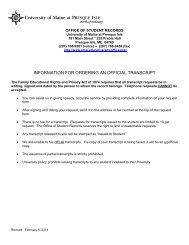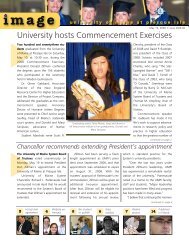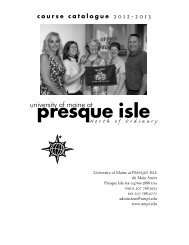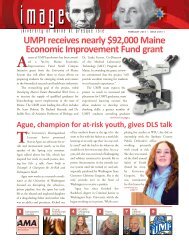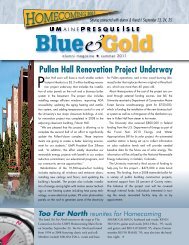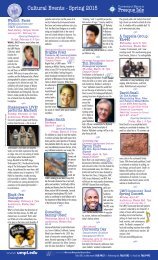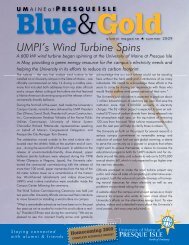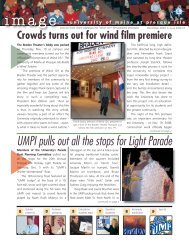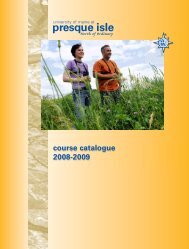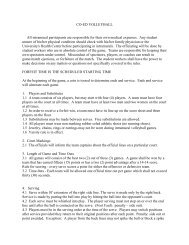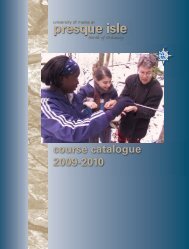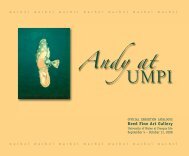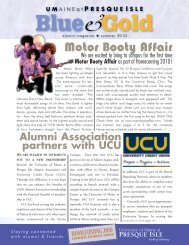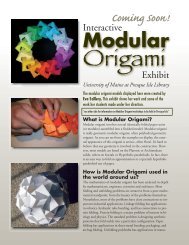Student teaching mid-term observation - University of Maine at ...
Student teaching mid-term observation - University of Maine at ...
Student teaching mid-term observation - University of Maine at ...
Create successful ePaper yourself
Turn your PDF publications into a flip-book with our unique Google optimized e-Paper software.
Form F-1<strong>University</strong> <strong>of</strong> <strong>Maine</strong> <strong>at</strong> Presque Isle<strong>Student</strong> Teaching Mid-<strong>term</strong> Observ<strong>at</strong>ion<strong>Student</strong> Teacher: ______________________________________________Observer: ______________________ Cooper<strong>at</strong>ing Teacher <strong>University</strong> SupervisorD<strong>at</strong>e <strong>of</strong> Observ<strong>at</strong>ion:School:Instruction to Observer: If appropri<strong>at</strong>e write specific detailed comments, referencing examples<strong>of</strong> events/interactions you observe. Use the back <strong>of</strong> each page as needed. When discussingstudent teacher <strong>observ<strong>at</strong>ion</strong>s, please reference relevant teacher standards.<strong>Maine</strong> Initial Teacher Standards1. Demonstr<strong>at</strong>es knowledge <strong>of</strong> the central concepts, tools <strong>of</strong> inquiry, and structures <strong>of</strong> thediscipline(s) s/he teaches and can cre<strong>at</strong>e learning experiences th<strong>at</strong> make these aspects <strong>of</strong>subject m<strong>at</strong>ter meaningful to students.2. Demonstr<strong>at</strong>es the ability to integr<strong>at</strong>e the concepts, tools <strong>of</strong> inquiry, and structures among thedisciplines.3. Demonstr<strong>at</strong>es a knowledge <strong>of</strong> the diverse ways in which students learn and develop byproviding learning opportunities th<strong>at</strong> support their intellectual, physical, emotional, andsocial development.4. Plans instruction based upon knowledge <strong>of</strong> subject m<strong>at</strong>ter, students, and curriculum goals.5. Understands and uses a variety <strong>of</strong> instructional str<strong>at</strong>egies and appropri<strong>at</strong>e technologies.6. Cre<strong>at</strong>es and maintains a classroom environment which supports and encourages learning.7. Demonstr<strong>at</strong>es the ability to support students' learning and well-being by engaging students,home, school, colleagues, and community.8. Understands and uses a variety <strong>of</strong> formal and informal assessment str<strong>at</strong>egies to evalu<strong>at</strong>e andsupport the development <strong>of</strong> the leaner.9. Demonstr<strong>at</strong>es an awareness <strong>of</strong> and commitment to ethical and legal responsibilities <strong>of</strong> <strong>at</strong>eacher.10. Demonstr<strong>at</strong>es a strong pr<strong>of</strong>essional ethic and a desire to contribute to the educ<strong>at</strong>ionpr<strong>of</strong>ession.Subject Area Observed:____ Arts/Humanities _____ Social Studies _____Special Educ<strong>at</strong>ion____ M<strong>at</strong>hem<strong>at</strong>ics _____ English/Language Arts _____ Science____ PE/Health_____ OtherType <strong>of</strong> Classroom (√ all th<strong>at</strong> apply)____ Regular Educ<strong>at</strong>ion Setting____ Field/GymnasiumAges/Grades <strong>of</strong> <strong>Student</strong>s:_____ Special Educ<strong>at</strong>ion Setting_____ Library/Media CenterTotal Number <strong>of</strong> <strong>Student</strong>s in class: ________
3=Exemplary 2=S<strong>at</strong>isfactory Progress 1=Not S<strong>at</strong>isfactory N/O= Not ApplicableStandard 1: Content Knowledge/Pedagogy 3 2 1 N/ADemonstr<strong>at</strong>es appropri<strong>at</strong>e knowledge <strong>of</strong> contentAltern<strong>at</strong>ive views <strong>of</strong> concepts are considered and discussed whenappropri<strong>at</strong>eUses accur<strong>at</strong>e content sources <strong>of</strong> inform<strong>at</strong>ionGuides the present<strong>at</strong>ion <strong>of</strong> content in an effective logical mannerLessons include specific and appropri<strong>at</strong>e objectivesTeaching str<strong>at</strong>egies are consistent with learning objectivesConnects content to real life applic<strong>at</strong>ions/students’ priorexperiences/prior learningEvidenceRecommend<strong>at</strong>ions3=Exemplary 2=S<strong>at</strong>isfactory Progress 1=Not S<strong>at</strong>isfactoryStandard 2: Integr<strong>at</strong>ion <strong>of</strong> concepts, tools <strong>of</strong> inquiry andstructuresUses reading and writing in <strong>teaching</strong> other contentN/O= Not Applicable3 2 1 N/AUses m<strong>at</strong>erial from other content areas in instructionEvidenceRecommend<strong>at</strong>ions
3=Exemplary 2=S<strong>at</strong>isfactory Progress 1=Not S<strong>at</strong>isfactory N/O= Not ApplicableStandard 3: <strong>Student</strong> Development and Diversity 3 2 1 N/AAdapts lessons to fit individual student needsDemonstr<strong>at</strong>es understanding <strong>of</strong> and sensitivity to issues <strong>of</strong> diversityand equity during the design, implement<strong>at</strong>ion and assessment <strong>of</strong>instructionSupports students’ physical, emotional, social , cognitive and moraldevelopmentDiscerns individual student and group differencesEvidenceRecommend<strong>at</strong>ions3=Exemplary 2=S<strong>at</strong>isfactory Progress 1=Not S<strong>at</strong>isfactory N/O= Not ApplicableStandard 4: Planning Instruction 3 2 1 N/ADevelops daily, and weekly plans linked to student needs andperformance, and adapted to student progress and motiv<strong>at</strong>ionDemonstr<strong>at</strong>es originality in lesson development within parameters<strong>of</strong> school curriculumArticul<strong>at</strong>es lesson goals and provides defensible r<strong>at</strong>ionales for thesegoalsProvides opportunity for individual practiceEvidenceRecommend<strong>at</strong>ions
3=Exemplary 2=S<strong>at</strong>isfactory Progress 1=Not S<strong>at</strong>isfactory N/O= Not ApplicableStandard 5: Instructional Str<strong>at</strong>egies 3 2 1 N/AChooses effective and appropri<strong>at</strong>e str<strong>at</strong>egies and m<strong>at</strong>erials to meetlearning goals and engage studentsMonitors and adjusts str<strong>at</strong>egies in response to learner feedbackUses multiple <strong>teaching</strong> and learning str<strong>at</strong>egies to engage students inactive learningDevelops clear, accur<strong>at</strong>e present<strong>at</strong>ions and represent<strong>at</strong>ions <strong>of</strong>conceptsIncludes the use <strong>of</strong> appropri<strong>at</strong>e technologyEmploys effective questioning and discussion techniquesEvidenceRecommend<strong>at</strong>ions3=Exemplary 2=S<strong>at</strong>isfactory Progress 1=Not S<strong>at</strong>isfactory N/O= Not ApplicableStandard 6: Management 3 2 1 N/ACre<strong>at</strong>es a comfortable, effective learning environmentEmploys principles <strong>of</strong> effective classroom organiz<strong>at</strong>ionUses a variety <strong>of</strong> str<strong>at</strong>egies to increase students’ desire andopportunity to learnCre<strong>at</strong>es an environment conducive to cooper<strong>at</strong>ive and independentworkAnticip<strong>at</strong>es and responds appropri<strong>at</strong>ely to student behaviorPreserves instructional time by minimizing disruptionsEvidenceRecommend<strong>at</strong>ions
3=Exemplary 2=S<strong>at</strong>isfactory Progress 1=Not S<strong>at</strong>isfactory N/O= Not ApplicableStandard 7: School, Home and Community Involvement 3 2 1 N/AWorks with others (community, parents, colleagues) to supportstudent learningEmploys str<strong>at</strong>egies to connect school, home, and communityEvidenceRecommend<strong>at</strong>ionsStandard 8: Assessment 3 2 1 N/AUses performance assessment or student portfoliosUses assessment to inform instructionUses a variety <strong>of</strong> formal and informal assessment str<strong>at</strong>egiesM<strong>at</strong>ches assessment types and str<strong>at</strong>egies to learning objectivesEvidenceRecommend<strong>at</strong>ions
3=Exemplary 2=S<strong>at</strong>isfactory Progress 1=Not S<strong>at</strong>isfactory N/O= Not ApplicableStandard 9: Ethical and Legal Responsibility 3 2 1 N/AMaintains confidentiality in dealings with students, parents, teachersand school personnelComplies with policies rel<strong>at</strong>ed to health and safetyDemonstr<strong>at</strong>es understanding <strong>of</strong> standard educ<strong>at</strong>ion laws andregul<strong>at</strong>ions governing student rights and teacher responsibilitiesInteracts with all students in an equitable mannerEvidenceRecommend<strong>at</strong>ionsStandard 10: Pr<strong>of</strong>essional Development 3 2 1 N/AMaintains a pr<strong>of</strong>essional demeanor and recognizes teacher’s role asa model for studentsParticip<strong>at</strong>es actively on work teams and committeesParticip<strong>at</strong>es in staff development opportunities and training sessionsDemonstr<strong>at</strong>es reflective practiceWorks collabor<strong>at</strong>ively with colleagues to achieve school goals andaddress problemsEvidenceRecommend<strong>at</strong>ions
SUMMARY(Strengths)(Areas <strong>of</strong> Need)Observer’s Sign<strong>at</strong>ure: __________________________________________D<strong>at</strong>e copy was given to the <strong>Student</strong> Teacher: _______________________



